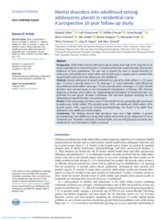Background
Child welfare and juvenile justice placed youths show high levels of psychosocial burden and high rates of mental disorders. It remains unclear how mental disorders develop into adulthood in these populations. The aim was to present the rates of mental disorders in adolescence and adulthood in child welfare and juvenile justice samples and to examine their mental health trajectories from adolescence into adulthood.
Methods
Seventy adolescents in shared residential care, placed by child welfare (n = 52, mean age = 15 years) or juvenile justice (n = 18, mean age = 17 years) authorities, were followed up into adulthood (child welfare: mean age=25 years; juvenile justice: mean age=27 years). Mental disorders were assessed based on the International Classification of Diseases 10th Revision diagnoses at baseline and at follow-up. Epidemiological information on mental disorders was presented for each group. Bivariate correlations and structural equation modeling for the relationship of mental disorders were performed.
Results
In the total sample, prevalence rates of 73% and 86% for any mental disorder were found in adolescence (child welfare: 70%; juvenile justice: 83%) and adulthood (child welfare: 83%; juvenile justice: 94%) respectively. General psychopathology was found to be stable from adolescence into adulthood in both samples.
Conclusions
Our findings showed high prevalence rates and a high stability of general psychopathology into adulthood among child welfare and juvenile justice adolescents in Swiss residential care. Therefore, continuity of mental health care and well-prepared transitions into adulthood for such individuals is highly warranted.

